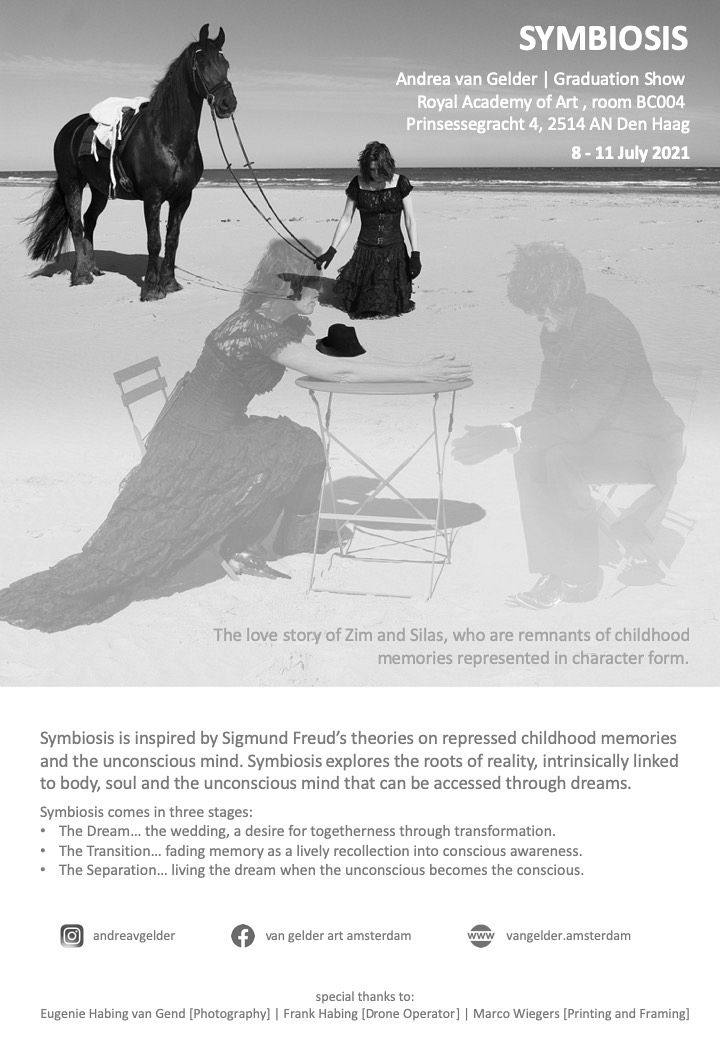
Andrea van Gelder
Keywords: Andreavgelder, Vangelder.amsterdam
Symbiosis is inspired by Sigmund Freud’s theories on repressed childhood memories and the unconscious mind. Repressed childhood memories impact on the development of human personality and identity, and the unconscious mind is accessed through dreams. Symbiosis is the love story of Zim and Silas, who are remnants of childhood memories represented in character form. Silas is a television character from a youth-series from the 80th. And (invader) Zim is a science-fiction dark comedy character.
Symbiosis comes in three stages: The Dream… the wedding: Silas searches in vain for Zim to marry. In her desperation of not finding Zim, she chooses to become him and thus fulfil her desire for togetherness through transformation. The Transition… fading memory: The love story ends when Zim fades away as a phantom memory and Silas returns as a lively childhood recollection into conscious awareness. The Separation… living the dream: The unconscious becomes the conscious. In addition to creating arts, I have worked in the field of mental health care for thirty years. In all that time, the leading questions from every person I encountered through my work have been: Where do I belong? Who loves me? Where do I feel safe? In Symbiosis I seek to explore the roots of my reality, intrinsically linked to body, soul and the unconscious mind.
Andrea van Gelder Graduation show KAKB 2021
PAINTED BRAIN. AN ARTIST LOOK AT THE WORLD.
Thesis
Summary of Thesis ‘Painted Brain. An artist look at the world’ I believe that the foundation of authenticity is nestled within the roots of the artist. And these artistic roots are intrinsically linked to the human body, soul and mind. There are ongoing internal dialogues during the process of creating an artwork, embodied by the language of the unconscious mind, the physical body and the human brain to answer the questions ‘what does my artwork offer visually’ and ‘what is my deepest motivation in becoming an artist’. When an artwork evokes a reaction in an individual viewer, a connection is established via the eye and brain, which is reflected in the body and soul. This can lead to a confrontation with the individuality of the viewer. But is this caused by the artist? Or the viewer? To the question, ‘does making art have a therapeutic reason’ my answer is, ‘yes’. The moment one chooses to be become an artist, means one chooses for a confrontation with one self. This choice is a collaboration between a variety of functions of the brain, the nervous system, the conscious and unconsciousness mind and the body.
Not knowing yet what is stored in the unconscious mind of the artist to be is caused by the fact that storage is not directly accessible through choice. The unconscious mind opens when activated by connecting with memory, by associating and to allow feelings, to form ideas and eventually when the body starts to move and starts to create. The human mind has many intriguing coping mechanisms to postpone or lock the storage of memory, which gives us the capability to navigate through life. The human mind is capable of not remembering, not believing, denying, or just ignoring something because we don’t know what to do with it, for whatever an individual’s reason. And mostly, we are unaware that the mind functions in this way. Intrinsic motivation comes from deep within. And once you are on track, there is no escape. Creation is a primary driving force, and the reward comes during the creative process and peaks when the work is finished and appreciated, whether there is financial gain or not. The personal gain is getting to know yourself better, whether consciously or subconsciously.